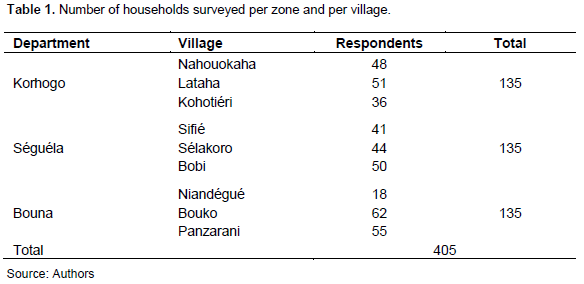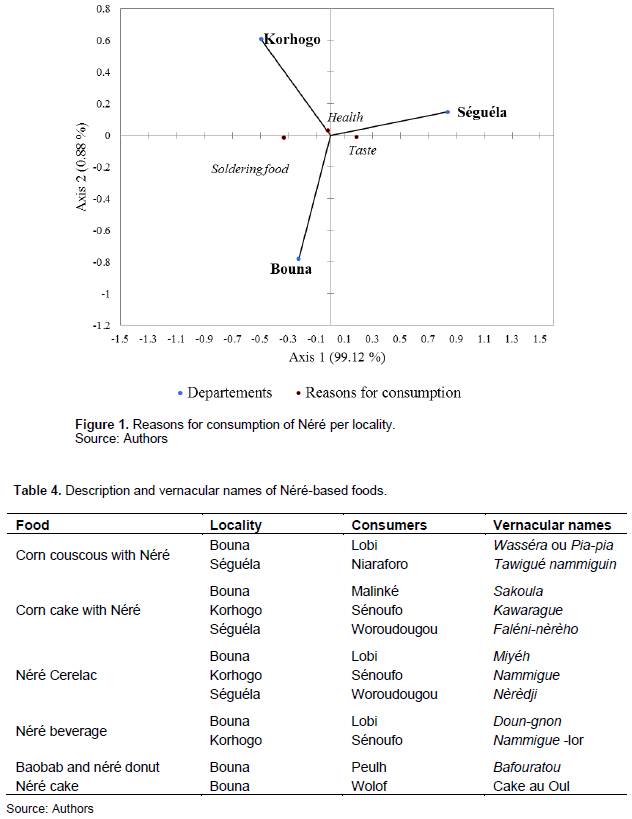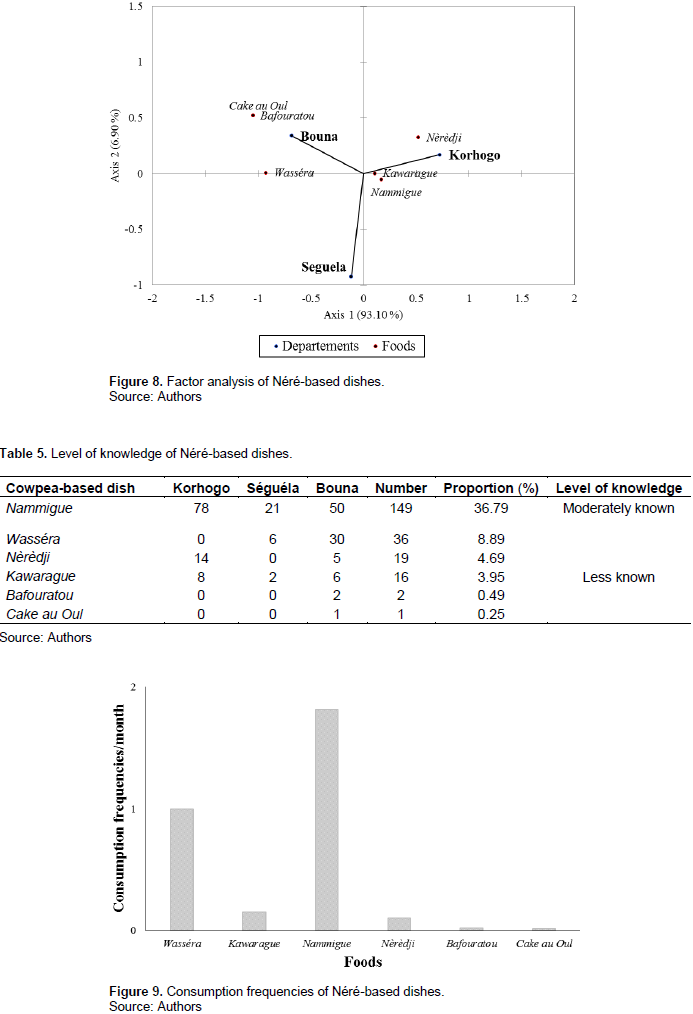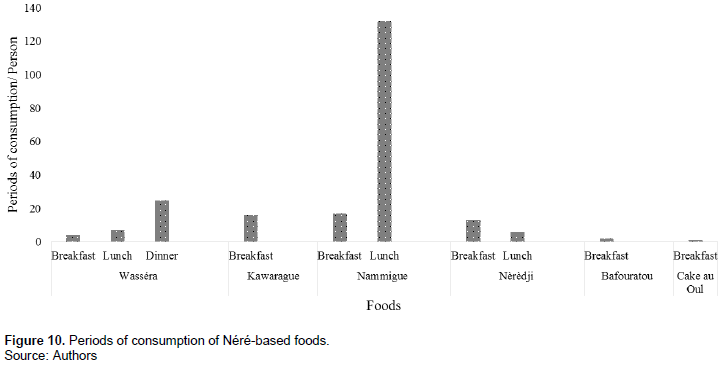Full Length Research Paper
ABSTRACT
The Néré (Parkia biglobosa L.) is a tree of the Mimosaceae family, typical of the semi-arid and sub-humid zones of West Africa generally found in the northern of Côte d'Ivoire. The yellow pulp on the seeds of Néré is consumed raw or used for the preparation of drinks or enters into the composition of many cereal foods. The objective of the present study was to identify the dishes integrating Néré pulp in the formulation, the process and the food habits based on its consumption. Thus, a food consumption survey was carried out in 135 households per department (Korhogo, Séguéla and Bouna) in the northern of Côte d'Ivoire. Data revealed that five cereals dishes and a beverage based on Néré pulp were consumed in investigated areas. The process and the consumption form of foods depend on consumers’ ethnic group and their origin region. Most people consume foods based on Néré pulp to have a good health. Among dishes, Nammigue was the most known and consumed food (36.79%) as a lunch with a consumption frequency of two times per month. Six foods based on Néré were identified and their processes were described.
Key words: Pulp, Néré, foods typology, consumption practices, household survey, Côte d’Ivoire.
INTRODUCTION
Néré (Parkia biglobosa L.) is a tree of the Mimosaceae family, typical of the semi-arid and sub-humid zones of West Africa. It is a wild edible fruit tree generally found in the North where it occupies a prominent place in people's lives (Kouamé et al., 2015; Arbonnier, 2009). The wild fruit tree Parkia biglobosa L (Néré) is widely distributed and consumed in the Poro (Korhogo), Worodougou (Séguéla) and Bounkani (Bouna) regions (Kouakou et al., 2020; Ambé, 2001). The fruits of P. biglobosa are long pods of about 45 cm, 2 cm wide, slightly arched, hanging in clusters on the club-shaped flower. During the ripening, the endocarp constantly fills the cavity between the seeds of the whole pod, which becomes powdery and light yellow at maturity. At maturity the flattened black seeds are embedded in a yellow pulp rich in sucrose (Mabetty, 2018). According to Touré (2020), the pulp of Néré is the sweet and yellow floury substance surrounding the seeds. It is rich in energy value and consumed raw or processed into a refreshing drink. The pulp of P. biglobosa constitutes a means of subsistence for local populations. The harvested mature fruits are used as food in the dearth season (Nyadanu et al., 2017). The pulp of the Néré has an interesting nutritional value, rich in sodium, potassium, calcium, zinc, b-carotene, ascorbic acid, riboflavin and also phenolic compounds. This pulp could therefore contribute to reducing malnutrition caused by micronutrient deficiencies and extreme hunger in developing countries (Bamigboye et al., 2012; Kouassi et al., 2018a). In addition, Néré pulp contains high dietary fibre content, making it essential for intestinal transit, prevention of obesity, intestinal diseases such as colon cancer and other gastrointestinal conditions and helps prevent diabetes (Nyadanu et al., 2017). Parkia biglobosa pulp can therefore contribute to human nutritional needs and be a good source of energy due to its high carbohydrate content. It can be used as a nutritional supplement (Aja et al., 2015). Thus, this pulp could fill micronutrient deficiencies in Côte d'Ivoire where malnutrition is a real public health problem. Indeed, some areas in Côte d'Ivoire can reach up to 40% for global acute malnutrition and over 5% for severe acute malnutrition. These deficiencies mainly affect women of childbearing age and children (N'goran, 2014; Schwartz and Grellety, 2010; WHO, 2009; FAO, 2008). An alternative to this situation could be the valorization of traditional wild fruit dishes such as Néré. The yellow pulp surrounding the seeds is eaten raw or used to make cold drinks (Andon et al., 2018) or used in many other cereal foods such as fritters and cakes (Lamien et al., 2011). There is very little data on dishes incorporating Néré pulp. Only recent studies (N'goran, 2014; Kouassi et al., 2018b) based on juices derived from Néré were available. There is a lack of literature on cereal foods made from Néré. Thus, in order to promote their access to consumers, the objective of this study was to inventory dishes incorporating Néré pulp in the formulation and determine their characteristics, that is, process, dietary habits and food consumption.
MATERIALS AND METHODS
The technical material consists of a household survey form with consumption practices sections such as food modes, food forms, consumption frequencies, and production processes of Néré-based dishes.
Survey areas
In each Néré widely distributed zone (Korhogo, Séguéla and Bouna), three villages were selected after a pre-survey based on the consumption of Néré pulp. Thus, the villages of Nahouokaha, Lataha and Kotchiéri (Korhogo), Sifié, Sélakoro and Bobi (Séguéla) and Niandégué, Bouko and Panzarani (Bouna) were surveyed.
Selection of surveyed households
Households were selected using the snowball technique. The size (n) of the households surveyed was calculated according to Dagnelie (1998) formula for an independent non-exhaustive sample based on Côte d’Ivoire population and housing census (RGPH, 2014):

To compensate errors in questionnaires that were incorrectly filled out, 20 additional households were added to calculate sample size (n). Thus, a total of 405 households were surveyed with 135 per department (Table 1).

Statistical processing
Data were entered using SPHINX Plus² (V5) software and then exported to SPSS 20.0 software for database. Statistical analyses were performed using XLSTAT 2016 software. The relationship between the dependent variables was assessed by Chi-square test and Z test at 5% threshold. Correspondence factor analyses (CFA) were performed for the comparison of more than 3 variables. Excel software was used to produce graphs of periods, consumption frequencies and level of knowledge of foods.
RESULTS AND DISCUSSION
Collection of Néré
In all the departments, most of consumers prefer to collect Néré in field (92.86-98.25%) than the payment into the market (2.63-8.33%) (Table 2). Néré is generally collected in pod (92.86 - 98.25%) than those of powder (1.75 - 7.14%) and pulp (0 - 1.19%) (Table 3). In Séguéla, consumers do not use Néré in pod form.

Reasons of Néré consumption
Data showed that Néré is mainly consumed in the three different localities for its health benefits and then for its taste. However, Néré is also consumed as a soldering food (Figure 1).
Dishes based on Néré
Six different Néré based dishes were identified. These dishes encountered in the different departments are corn or millet couscous with Néré, corn cake with Néré, Néré cerelac, wafer, Néré beverage and Néré cake. These dishes were called in different names depending on thelocality or ethnicity (Table 4).

Production process of Néré based dishes
Production of Wasséra
Wasséra is a corn couscous with Néré. For its production, 1 kg of corn flour is mixed with 1 kg of Néré pulp powder. After homogenization, two processes can be applied: either the mixture of flours is directly overturned in a pot on soft fire containing 100 to 200 g of shea butter for a cooking of 5 to 10 min during which the whole is constantly stirred to obtain the floury Wasséra or the mixture of flours is sprinkled with water for the formulation of granules for 10 to 20 min steam cooking. After cooking, the granules are relayed in 100 g of melted butter or 100 mL of refined vegetable oil to obtain the granular Wasséra (Figure 2).
Production of Nammigue
Two processes are used to obtain Nammigue. On the first hand, a kilogram (83 g) of millet is roasted, ground and sifted to produce flour. This flour was mixed with 17 g of Néré powder then the whole was relayed in 300 mL of water. On another hand, 100 g of Néré powder was directly relayed in 300 mL of water. In both cases, the slurry was consumed sweetened or spiced with chili powder (Figure 3).
Production of Kawarague
One kilogram of Néré powder was mixed with 1 kg of corn flour and 30 g of salt. 1.5 L of water was gradually added for the homogenized mixture. The mixture was kneaded and the dough obtained was kneaded by hand for 10 to 15 min before frying to obtain doughnuts in the form of patties (Figure 4).
Production of Bafouratou
One kilogram of Néré powder was mixed with 1 kg of baobab powder and 1 kg of millet flour to constitute a homogeneous medium. To the mixture obtained, 1.5 L of water was added and the whole was mixed and kneaded by hand for 10 to 15 min. The resulting dough was fried to obtain fritters in the form of patties (Figure 5).
Production of Cake au Oul
A mass of 700 g of butter was melted and mixed with 250 g of sugar and 5 to 10 g of baker's yeast. To this mixture, 6 to 7 fresh eggs and 0.5 L of water were added and the whole was stirred until homogeneous medium was obtained. To this medium, 1 kg of Néré powder and 500 g of durum wheat flour were gradually added. The final dough obtained was kneaded by hand for 10 to 15 min and then left to rest (incubation of 5 to 10 min) before cooking in the oven for 20 to 30 min (Figure 6).
Production of Nèrèdji
The production process of Nèrèdji is described in Figure 7. Ten grams of yellow Néré powder were diluted in 100 ml of water or milk and the mixture was homogenized. The resulting solution was consumed by adding a tablespoon of honey or 5 g of sugar.
Classification of Néré-based foods
Among foods based on Néré, PCA showed that Nammigue and Kawarague are specific to Korhogo, Séguéla and Bouna consumers. Wasséra, Bafouratou and Cake au Oul are specific to Bouna, while Nérédji is specific to Korhogo than Séguéla and Bouna (Figure 8).
Level of knowledge of Néré-based dishes
With a proportion of 36.79% Nammigue is a food that is
moderately known in all the investigated localities where Wasséra (8.89%) tops the list of little-known foods (Table 5).
Periods and frequencies consumption
Data in Figure 9 reveal that Nammigue is the most consumed food with a frequency of 2 times/month followed by Wasséra with a frequency of consumption of 1 time/month. All dishes are consumed at any time except Cake au Oul which is consumed at breakfast. Nammigue (32.59%) is more consumed at lunch (Figure 10).





DISCUSSION
The study was conducted to identify the consumption practices of Néré pulp (Parkia biglobosa L.) in the departments of Korhogo, Séguéla and Bouna in northern Côte d'Ivoire. The data showed that six Néré-based dishes were identified (maize or millet couscous in Néré, maize fritters in Néré, cerelac in Néré, fritters in Néré, drinks in Néré and cakes in Néré) in the localities studied. However, the names of these foods differ according to locality/ethnic group. This diversity of foods produced from Néré pulp could reflect the importance of this fruit in the diet of rural populations. These foods would therefore contribute to the food security of these populations. These results corroborate the studies of Ouattara et al. (2016) which revealed the importance of wild fruits in human nutrition. Nyadanu et al. (2017) also confirmed the importance of P. biglobosa pulp in the diet of rural populations. According to these authors, Néré pulp is used as a subsistence food in times of food scarcity and is also used as infant food. While according to studies of Sackou et al. (2020) on food insecurity in the city of Abidjan, only 3.8% of households were food secure. Thus, the popularisation of these foods could contribute to the reduction of food insecurity in developing countries, particularly in Côte d'Ivoire. The identified Néré pulp-based foods are consumed more as meals than as drinks, with a meal/drink ratio of 5:1. Néré pulp is consumed as fritters, cakes, cereals and drinks. These different forms of food use in the form of drinks or meals are in line with those described by several authors such as Toure et al. (2020) and Vivien and Faure (2011). These authors confirm that the mealy pulp of the Néré fruit can be consumed raw, in jam or diluted in a liquid to prepare a sweet and refreshing drink. Similarly, Touré (2018) and Lamien et al. (2011) found that the flour of Néré fruit pulp mixed with cereal flour can be consumed in couscous, porridge, fritters and cakes. Studies of Arinola et al. (2019) also revealed that Néré pulp has appreciable dietary and functional properties, both in oil and water, that may qualify it for use in food. Five of the six foods identified are specific to each locality studied. It is believed that the specificity of these foods in each locality is related to differences in culture, customs and also eating habits of the populations. Al-Fatimi (2021) state that there is a strong relationship between local people and their environment, and that traditional knowledge is therefore passed on from generation to generation. Kruger and Gericke (2002) and Thurber et al. (2016) with a meal/drink ratio of 5:1. Cowpea pulp is consumed as fritters, cakes, cereals and drinks. These different forms of food use in the form of drinks or meals are in line with those described by several authors such as Touré (2020) and Vivien and Faure (2011). These authors confirm that the mealy pulp of the cowpea fruit can be consumed raw, in jam or diluted in a liquid to prepare a sweet and refreshing drink. Similarly, Touré (2018) and Lamien continue this same view by stating that it is evident that there is a divergence in the foods consumed, as culture is one of the important factors that influence consumer attitudes towards a given food. For the preparation of all these dishes, wild fruits are mainly collected in the field (92.86 to 98.25%). This result is explained by the fact that the surveys were conducted in rural areas and the abundance of this fruit in these localities. Indeed, Avana-Tientcheu et al. (2019) and Koura et al. (2013) confirm that in Côte d'Ivoire, savannah populations preserve the dwarf tree for its numerous virtues. Koné et al. (2020) make a similar observation on the biodiversity of plant species in the north of Côte d'Ivoire, showing that wild fruit trees such as the dwarf tree are protected by local populations because of their high ethnobotanical value. The use of the dwarf tree in the preparation of dishes is explained by the satisfaction of health problems and the search for particular tastes. In addition, the dwarf tree is considered an emergency food. This diversity in the reasons for consumption of this fruit in different localities could be related to the low level of information about the importance of this fruit. According to Soma Massieke et al. (2017), the lack of knowledge of all the benefits of the fruit may influence food uses. Indeed, as a health product, Néré pulp is used as a mild diuretic and purgative (Arbonnier, 2009; Vivien and Faure, 2011; Aubréville, 1950). It also has a beneficial effect on health due to its high content of flavonoids, which have antioxidant activity on hydroxyl radicals and free radicals. It can also prevent congestive heart failure due to its composition of cardiac glycosides (Arinola et al., 2019). These foods developed by these populations are most often consumed at any time of the day. However, with a consumption rate of 36.79%, Nammigue appears to be the best known and most consumed food in Néré, with a consumption frequency of about 2 times per month. This low consumption rate of the main staple food of Néré could be explained by the fact that Néré is not a food of choice for consumers. This hypothesis is supported by the results of Lamien et al. (2011) which reveal that yellow Néré pulp is much more used only to cover the food deficit of some families during the lean season. This result could also be explained by the modernisation of the rural areas surveyed. It is in this vein that Muhammad et al. (2015) argue that modernisation disrupts and creates conflicts with the cultural traits of rural people by changing their lifestyles. According to Oryema et al. (2015), changing lifestyles promote neglect of wild food resources, thereby reducing their use. It is therefore important to encourage rural populations to consume these foods in order to reduce the rate of food insecurity in Côte d'Ivoire.
CONCLUSION
The authors have not declared any conflict of interests.
ACKNOWLEDGEMENTS
The authors thank the households and guides who gave their time for the success of these surveys. They also thank doctoral student KOUADIO Yapo hypolithe for his help during the surveys.
REFERENCES
|
Aja PM, Offor CE, Orji OU (2015). Proximate and a Nutrient Compositions of Parkia biglobosa Fruits in Abakaliki, Ebonyi state, Nigeria. International Journal. Current Microbiology Applied Sciences 4(2):394-398. Available at: |
|
|
Al-Fatimi M (2021). Wild edible plants traditionally collected and used in southern Yemen. Journal of Ethnobiology and Ethnomedicine 17(1):1-21. |
|
|
Ambé GA (2001). Les fruits sauvages comestibles des savanes guinéennes de Côte d'Ivoire: état de la connaissance par une population locale, les Malinkés. Biotechnology Agronomy Society Environment 5(1):43-58. Available at: |
|
|
Andon GS, Assouman SF, Soro GR (2018). Loss of trees in the agricultural landscape of northern Côte d'Ivoire: the case of the Korhogo department. Revue de Géographie Tropicale et d'Environnement 2:49-60. |
|
|
Arbonnier M (2009). Arbres, arbustes et lianes des zones sèches d'Afrique de l'Ouest. Editions Quae 576. |
|
|
Arinola SO, Oje OJ, Omowaye-Taiwo O (2019). Evaluation of physicochemical properties and phytochemical composition of african locust bean (Parkia biglobosa) pulp. Applied Tropical Agriculture 24(1):64-69. Available at: |
|
|
Aubréville A (1950). Flore forestière soudano-guinéenne: A.O.F., Cameroun, A.E.F. Paris: Société d'Editions Géographiques, Maritimes et Coloniales 525 p. |
|
|
Avana-Tientcheu MLA, Keouna S, Dongock DN, Mouga BM (2019). Stand structure and domestication potential of Parkia biglobosa in the Tandjilé-Ouest region (Chad). International Journal of Biological and Chemical Sciences 13(1):219-236. |
|
|
Bamigboye AY, Adepoju OT, Oyinsan O, Kabir H (2012). Micronutrient potentials and contribution to nutrient intake of four commonly consumed local condiments and spices in South-Western Nigeria. Nigerian Journal Nutritional Sciences 33(1):57-61. Available at: |
|
|
Dagnelie P (1998). Theoretical and applied statistics. Paris, De Boeck & Larcier, Belgium 2:659. |
|
|
Food and Agriculture Organization, FAO (2008). Nutritional education program integrated to community nutrition centers Côte d'Ivoire. FAO Nutrition and Consumer Protection Division (AGN) 2. |
|
|
Koné CHK, Niamien JMC, Coulibaly K, Kadio A (2020). Biodiversité et statut de conservation des espèces végétales du site de la future zone agro-industrielle de Korhogo (Nord Côte d'Ivoire). International Journal of Innovation and Applied Studies 28(2):468-477. Available at: |
|
|
Kouakou YB, Malan DF, Kouassi KG, Diop AL, Bakayoko A (2020). Disponibilité de quelques plantes alimentaires spontanées utilisées par les populations Koulango et Lobi de la périphérie Est du Parc National de la Comoé, Côte d'Ivoire. Afrique Science 16(3):33-50. |
|
|
Kouamé NMT, Soro K, Mangara A, Diarrassouba N, Coulibaly AV, Boraud NKM (2015). Etude physico-chimique de sept (7) plantes spontanées alimentaires du centre-ouest de la Côte d'Ivoire. Journal of Applied Biosciences 90:8450-8463. |
|
|
Kouassi AK, Beugré MAG, Kouassi NK, N'dri DY, Amani GN, Gnakri D (2018b). Biochemical characterization of juices from three wild fruit species consumed in Côte d'Ivoire "Adansonia digitata, Parkia biglobosa and Tamarindus indica". Open Science Journal 3(4):10. |
|
|
Kouassi AK, Kouassi NK, Beugré MAG, N'dri DY, Amani GN, Gnakri D (2018a). Glycemic index and glycemic load of wild edible fruit juices (Adansonia digitata, Tamarindus indica and Parkia biglobosa) consumed in Côte d'Ivoire. Journal of Biosciences and Medicine 6(1):63-74. |
|
|
Koura K, Mbaide Y, Ganglo JC (2013). Phenotypic and structural characteristics of the Parkia biglobosa (Jacq.) population in North Benin. International Journal of Biological and Chemical Sciences 7(6):2409-2425. |
|
|
Kruger R, Gericke GJ (2002). A qualitative exploration of feeding and weaning practices, knowledge and attitudes about nutrition in rural areas. Public Health Nutrition 6(2):217-223. |
|
|
Lamien N, Ekué M, Ouedraogo M, Loo J (2011). Parkia biglobosa, Néré: Conservation et utilisation durable des ressources génétiques des espèces ligneuses alimentaires prioritaires de l'Afrique subsaharienne. Bioversity International, Rome, Italie 8. Available at: |
|
|
Mabetty T (2018). «Le Néré, un arbre du patrimoine de la Haute Guinée», Belgeo. Available at: |
|
|
Muhammad S, Muhammad NSh, Summer F, Shahid H, Touqeer A (2015). Impact of modernization and changing traditional values of rural setup in district khushab. Journal of Social Sciences Pakistan 1(10):394-397. Available at: |
|
|
N'Goran P (2014). Food and Nutritional Security in Côte d'Ivoire: Current situation, challenges. National Nutrition Program 42. |
|
|
Nyadanu D, Amoah RA, Obeng B, Kwarteng A, Akromah R, Aboagye L, Adu-Dapaah H (2017). Ethnobotany and analysis of food components of African locust bean (Parkia biglobosa (Jacq.) Benth.) in the transitional zone of Ghana: implications for domestication, conservation and breeding of improved varieties. Genetic Resources and Crop Evolution 64:1231-1240 |
|
|
Oryema C, Origa HO, Roos N (2015). Influential factors to the consumptions of edible wild fruits and products in the post conflict District of Gulu, Uganda. Journal of Natural Sciences Research 5(10):2224-3186. |
|
|
Ouattara ND, Gaille E, Stauffer FW, Bakayoko A (2016). Floristic and ethnobotanical diversity of wild edible plants in the Department of Bondoukou (North East of Côte d'Ivoire). Journal of Applied Biosciences 98:9284-9300. |
|
|
RGPH (2014). General Population and Housing Census 5. |
|
|
Sackou KJ, Lobilé YH, Kouadio KKL (2020). Household food insecurity and association with sociodemographic factors in Abidjan. European Journal Public Health 30(5):166-220. |
|
|
Schwartz H, Grellety Y (2010). Evaluation de la prise en charge de la malnutrition aiguë Côte d'Ivoire: Rapport de mission. UNICEF Bureau Régional de l'Afrique de l'Ouest et du Centre 29 p. |
|
|
Soma Massieke AAR, Tapsoba FW, Kabore D, Seogo I, Tankoano A, Dicko MH, Toguyeni A, Sawadogo-lingani H (2017). Study on the production capacity, the marketing circuit and the consumption of zoom-koom sold in the city of Ouagadougou in Burkina Faso. International Journal of Biological and Chemical Sciences 11(5):2294-2305. |
|
|
Thurber KA, Banwell C, Neeman T, Dobbins T, Pescud M, Lovett R, Banks E (2016). Understanding barriers to fruit and vegetable intake in the Australian Longitudinal Study of Indigenous Children: A mixed-methods approach. Public Health Nutrition 20(5):832-847. |
|
|
Touré AS (2020). Etude de la phytochimie et l'activité antiradicalaire de la pulpe de fruit de Parkia biglobosa pour la prise en charge de la malnutrition. Thèse de la Faculté de Pharmacie, Université des sciences des techniques et des technologies de Bamako 100. Available at: |
|
|
Touré M (2018). Le Néré, un arbre du patrimoine de la Haute Guinée. Belgian Journal of Geography. URL: http://journals.openedition.org/belgeo/21569; DOI: 10.4000/belgeo.21569. |
|
|
Vivien J, Faure J (2011). Arbres des forêts denses d'Afrique centrale P 565. |
|
|
WHO (2009). Global prevalence of vitamin A deficiency in populations at risk 1995-2005: WHO global database on vitamin A deficiency. World Health Organization. 55. Available at: |
|
Copyright © 2024 Author(s) retain the copyright of this article.
This article is published under the terms of the Creative Commons Attribution License 4.0